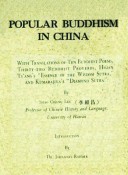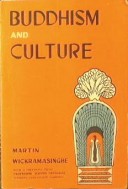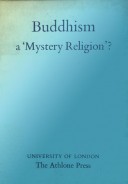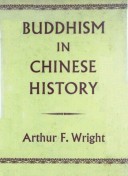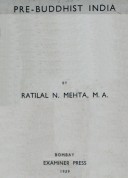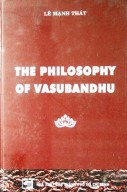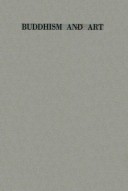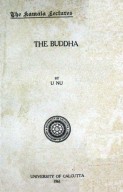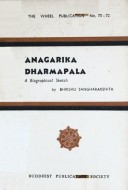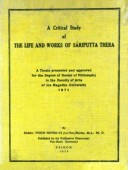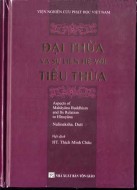Tìm Sách
Sách tiếng Anh-English >> Popular Buddhism In China
Thông tin tra cứu
- Tên sách : Popular Buddhism In China
- Tác giả : Shao Chang Lee
- Dịch giả :
- Ngôn ngữ : Anh
- Số trang : 52
- Nhà xuất bản : University of Hawaii
- Năm xuất bản : 1938
- Phân loại : Sách tiếng Anh-English
- MCB : 1210000002620
- OPAC :
- Tóm tắt :
FOREWORD
The Diamond Sutra (Vajracchedika Prajna Paramita, or limply Maha Prajna Paramita Sutra) for the attainment of the Highest Perfect Wisdom (Anuttara Samyak Sambodhi) is one of the numerous Discourses delivered by the Lord Sakyamuni Buddha during his 45 years of administration to the people of his time, and is found in one of the three Great Divisions of the Tripitaka (The Three Baskets of Buddhist Scriptures consisting of the Sutra Pitaka, Vinaya Pi taka, and Abhidharma Pitaka).
This Sutra (in Chinese: Kim Kong Keng) has been translated into Chinese from Sanskrit after die Great Demise of the Buddha, ft reflects the result of the Lord’s long and arduous experience in his quest for enlightenment. Prajna (wisdom) is the basis of this discourse. It is said to be akin to combustion—the more the fire is fed with fuel, the higher and more lively will the flames burn; but smoulders silently when it is left untouched. It is on this principle that the difierent systems of Sagehood are based.
In the Diamond Sutra is found the three steps of spiritual cultivation. They are the observation of Moral Precepts (Sila), concentration of the mind and meditation (Samadhi), and the cultivation of wisdom (Panna). The practice of the Moral Precepts pave the way to concentration and meditation, and these in turn produce wisdom. The 6 Paramitas (Virtues), or die Six Means of Crossing the Sea of Sangsara (Transmigration) are die paths all Buddhists must tread. And as is said in the Saddharma Pundarika Sutra: “…………..wisdom is not easy for one to enter……………”
The Lord Buddha first preached this Sutra to a disciple, Subhud and 1250 Bhikshus in the Jetavana Grove (given to die Brotherhood by Anatha-pindika) in the Kingdom of Shravasd.
There are altogether 6 translations of this Sutra, of which this one is considered to be the best. During the 11th Century B. E. (Buddhist Era), the great Indian missionary, Bodhidharma brought the Doctrine of Meditation (Sanskrit: Dhyana; and Chinese: Chan) to China. This Diamond Sutra was the focus of sustained contemplation, and for more than 1,000 years was used as the object of study and researches. Commentaries and critical analysis have been written by more than 700 Buddhist philosophers and writers, which more than prove the importance of this Sutra.
I first read it at the age of 12, at Chuan-Chew Monastery. When I came to the 14 th Chapter in which the Lord Buddha said to Subhud: “once in a previous life, the King of Kalinga mutilated my body. It was the time when all parts of my body were being cut and sliced………………,” I could not go on reading it, but with a shudder closed the book. The following year I had my head shaved and became a Buddhist monk at Guat Tai. I adored this Sutra and read it extensively. When I chanted up to Section 16, in which is said: good men and good women who receive and retain this Discourse: the evil-doer’s destiny is the inevitable result from sins committed in his past mortal lives. The present misfortunes are the reactions of his bad past. As soon as he has balanced up his evil deeds with virtuous ones, he will be in a position to seek salvation and attain the incomparable enlightenment”; I perspired profusely despite the fact that it was a wintry night.
At the outbreak of the War of Resistance in China, the Rev. Hong It and I lived together at Seng Thean Monastery. Chief Justice Phiak Kuay asked me to invite a preacher to preach the Diamond Sutra. I agreed, and Rev. Hong It was invited to do die preaching. When the following passage was read, its full significance dawned upon me. It runs thus: “Subhuti, if one Bodhisattva-Mahasattva bestows in charity sufficient of the Seven Treasures to fill as many world as there be sand-grains in the river Ganges, and another, realising that all things are egoless, attains perfecdon through padent forbearence, the merit of the latter will far exceed that of the former.”
I wish to emphasise that Lord Buddha went through numerable kalpas (aeons) leading a Bodhisattva’s life; relinquishing what man cannot relinquish; doing what man cannot do; and forbearing what man cannot forbear. How great and noble is He!
During the 2,500 Anniversary of the Jay anti of the Lord Buddha I pray that His teachings may spread far and wide throughout the whole world.
With the unfaltering determination and help of the Buddhist scholars, Mr. it Mrs. Lim Peng Chcow; Mr. it Mrs. Koo Soo Jin, and with the initiative taken by Mr. Ho Soo Hoo it is now possible again to reprint the Chincse-English translation of this Sutra. Out of the 3,000 copies of this edition, some 2,500 will be sent to India for free distribution during Lord Buddha’s celebration.
This Sutra is published in the hope that all those who read it will derive immense benefit from the teachings embodied in it
PEACE TO ALL BEINGS!
19th March, 2499 B. E.
Rev. Kong Ghee,
Beow Hiang Lim Temple,
Penang Hill Road,
Penang.
FOREWORD II
The purpose of this small volume is to answer some of the more important questions on Chinese Buddhism asked by interested students in classes on Chinese history, Oriental religions, and Chinese civilization, conducted at the University of Hawaii since 1922. It assumes the form of five tides, which present a concise account of the development of Buddhism in China, a collection of current Buddhist proverbs, a set of ten poems on Buddhism as a unifying religion, a new translation of Hsiian Ts’ang’s Essence of the Wisdom Sutra, and a fresh rendering of Kumarajiva’s The Diamond Sutra.
The account of the development of Buddhism in China is a summary of a series of eight lectures on the subject delivered annually before the class on Oriental religions. The translations of the sutras, poems, and proverbs were made and used in connection with the lectures.
The author is grateful to Mr. William E. Colby of San Francisco for showing him the ten poems written on a beautiful K‘ossu scroll depicting the five hundred Lohans. The scroll, which is now the property of Mr. Colby, was originally owned by Emperor Chien Lung (1736-1796). The ten poems were written in beautiful Chuan style by an apparently learned and devote Chinese scholar who was converted to Buddhism and who preferred to remain unknown.
The author wishes to thank Mr. Henry Inn for the picture showing the “Precious Hall of the Great Hero” in Lingyin Monastery and Mrs. J. Scott Crocker for the picture showing the Chinese conception of the historical Buddha which she obtained for him in Berlin. The other two illustrations are from the author’s collection.
To Dr. Ch’en Shou-yi, thanks are due for reading over the manuscript and giving valuable suggestions and help. Thanks are also due Dr. David L. Crawford, President of the University of Hawaii, Professor Gregg M. Sinclair, Director of the Oriental Institute, and Mr. Wang Yun-wu, Managing Director and Editor in chief of the Commercial Press, for their interest and encouragement. The author is indebted to his other esteemed colleagues and the students for their never-failing interest in his work. Lastly, he is deeply indebted to Dr. Johannes Rahder, visiting professor at the University of Hawaii from Leiden, 1937-1938. for criticism and for an introduction which he has so kindly written.
Author: Shao Chang Lee
Oriental Institute
University of Hawaii
Honolulu, T. H.
November, 1938.
CONTENTS
Foreword I
Foreword II
Introduction, by Dr. Johannes Rahder, Professor of Japanology, Leiden University Holland; Visiting Professor of Oriental Langnages, University of Hawaii, 1937-1938
Buddhism in China
Buddhist Proverbs
Essence of the Wisdom Sutra
The Diamond Sutra
INTRODUCTION
Mr. Shao Chang Lee is to be congratulated on the successful completion of the arduous task of making Chinese Buddhism intelligible to the English-speaking world.
Though many great Chinese scholars have translated the Confucianist and other classical Chinese philosophical systems to the West, the field of Buddhist studies and the interpretation of Buddhist philosophy in terms intelligible to Western intellectuals has been sadly neglected by Chinese leaders of thought.
In Mr. Shao Chang Lee’s excellent translation of The Diamond Sutra, The Wisdom Sutra, and the ten Buddhist poems arc equally evident his philosophical acumen, his keen philosophical insight, his firm grasp of elusive thought patterns and his delicate sense of literary beauty.
It is to be hoped that a great many Western readers may enlarge their intellectual horizon and enrich their spiritual experience by perusing and enjoying this precious book.
Johannes Rahder
Honolulu, T. H.
June 28, 1938.
BUDDHIST PROVERBS
- The Truth of Buddha is infinite; the door of Truth is wide open.
- Without suffering one cannot become a Buddha.
- The mind of a child is the mind of a Buddha.
- When you pray; pray to one Buddha only.
- When all is well, one neglects to bum incense; when in pressing need, one embraces the Buddha’s feet.
- The foundation of Buddhism is Compassion; its door is Convenience.
- In every home there is a Goddess of Mercy; in every place there is an Amitabha Buddha.
- First extinguish the fire in your heart, then light the lamp before the Buddha.
- Wherefore light a lamp if the mind is not enlightened; wherefore recite a sutra if the mind is not fair?
- Provide conveniences to others at all times; accumulate merits of all kinds.
- To save one human life is better than to build a seven storied pagoda.
- To do one good deed is better than to construct a nine storied pagoda.
- Better bestow blessings near by than burn incense afar.
- Each receives in accordance with what he cultivates.
- Merit is never in vain.
- Hundred yean elapse accompanying a mere change; myriad things become void at the turning of the head.
- Man dies even as a lamp goes out.
- The bright moon is not always round; the multicolored clouds arc easily scattered.
 Facebook
Facebook
 Google
Google
 Google+
Google+
